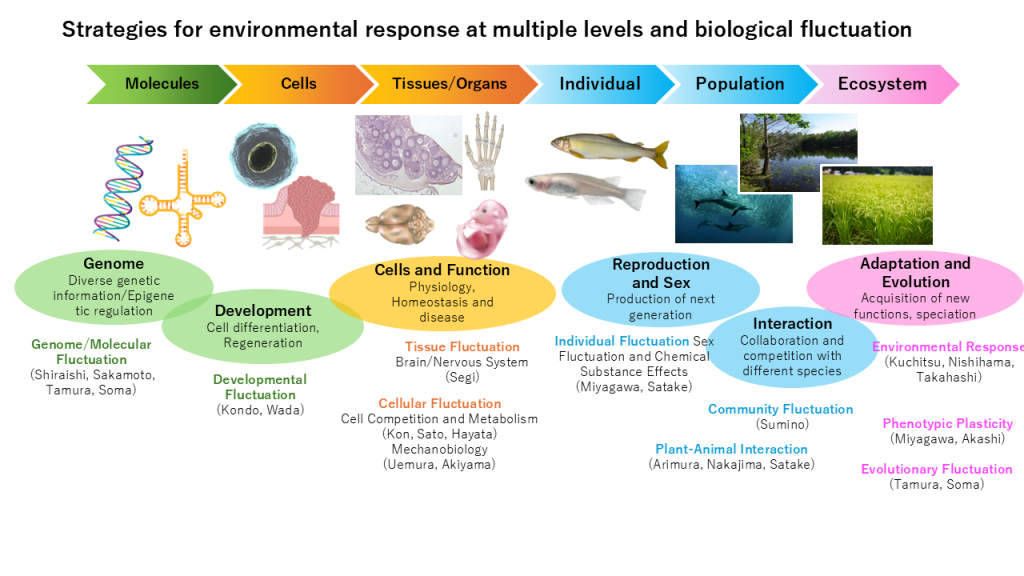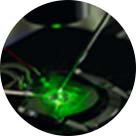Background
Previous research initiatives within the Comprehensive Research Institute, the Division of Agri-Biotechnology (2015-2019) focusing on “food” and the Division of Biological Environment Innovation (2020-2024), which addressed “environment”. These studies highlighted various environmental and societal challenges faced by living organisms, clearly demonstrating that a rapidly changing and harsh environment compels life to adapt for survival and propagation. Under such circumstances, it is an urgent imperative to elucidate the impact of the environment on biological activity and scientifically clarify the fundamental basis for the survival and prosperity of organisms, particularly their strategies for environmental response and of biological diversity.
Objectives
Addressing global environmental issues requires understanding organisms’ inherent adaptive capacity. We have termed the driving force enabling organisms to flexibly respond to diverse internal and external environments, and to adapt by altering their form and function, as “biological fluctuations”. This research division aims to identify and comprehend biological fluctuations across a wide range of biological phenomena, thereby understanding the fundamental principles by which organisms respond and change in adaptation to the environment. This endeavor seeks to generate novel research concepts that will provide insights into resolving contemporary environmental challenges.
What are biological fluctuations?
We define “biological fluctuations” as the driving force enabling organisms to flexibly respond to diverse internal and external environments, adapting through changes in their morphology and function. Biological fluctuations possess the following characteristics:
•”Fluctuations” are observed at all hierarchical levels, including molecular, cells, tissues, organs, individuals, populations, and ecosystems.
•For instance, developing cells exhibit flexibility; their fate is not solely determined by genome, but guided by environmental sensing and intricate signaling, enabling proper differentiation and adaptation.
•These biological fluctuations varies across species and developmental stages, even for identical biological phenomena.
•While appearing unstable, biological fluctuations ultimately contribute to robust macro-scale systems, supporting the production of next-generation evolution, and overall health.
Research Activities
We define “biological fluctuations” as the driving force enabling organisms to flexibly respond to diverse internal and external environments, adapting through changes in theirmorphology and function.
Within this division, each member will observe “biological fluctuations” in their respective research areas to elucidate the mechanisms of organisms’ inherent adaptive capacity. We will clarify both unique and common mechanisms of these fluctuations across various species and cells, revealing the specific and universal principles of environmental response. Common research themes include establishing new model systems for biological responses, developing novel analytical techniques, elucidating environmental sensing mechanisms, and clarifying signal transduction, gene expression, and metabolic pathways.
Cellular fluctuations enable responses to internal and external environments, ensuring optimal development, growth, and homeostasis in individuals. Robustness at ecosystem levels is maintained by biological diversity, which represents a form of biological fluctuation. Identifying and clarifying fluctuations at molecular and cellular levels across all biological phenomena will reveal fundamental principles of environmental response, providing pathways to resolve contemporary environmental challenges.
Members
Biological fluctuations are phenomena observed across different hierarchical levels: molecular, cellular, tissue/organ, individual, population, and ecosystem. This research division will categorize these into four groups: ① Molecular, ② Cell/Tissue/Organ, ③ Individual/Population, and ④ Ecology/Evolution, with each group advancing the elucidation of the molecular basis of life fluctuations. Emphasis will also be placed on interactions between different hierarchical levels to unveil robust environmental response capabilities that are unpredictable from the behavior of individual components.
•Molecular level
Members: Shu Kondo, Mitsunori Shiraishi, Naoyuki Wada, Takuya Sakamoto•Cellular/Tissue/Organ level
Members: Eri Segi, Masayoshi Hayata, Satoshi Sato, Shunsuke Kon, Yoshitsugu Akiyama, Masao Uemura
•Individual/Population level
Members: Shinichi Miyagawa, Genichiro Arimura, Shinichi Satake, Yutaka Sumino, Ushi Nakajima
•Ecology/Evolution level
Members: Fuminori Takahashi, Koji Tamura, Akiko Soma, Ryuichi Nishihama, Kazuyuki Kuchitsu,
Hiroshi Akashi













